










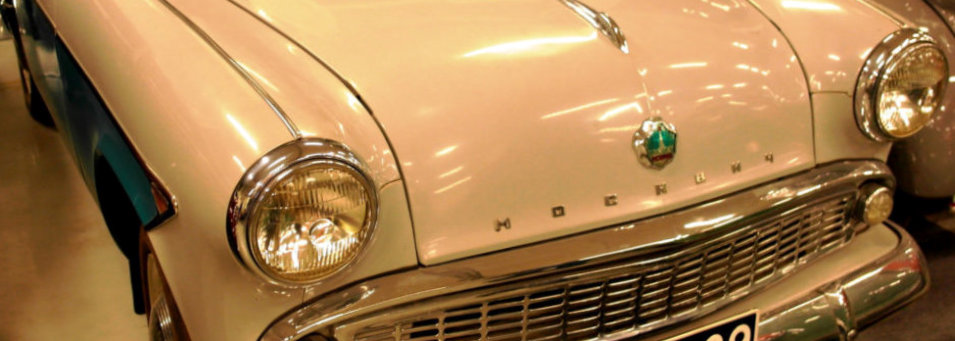

A 407 came third in class at the 1000 Lakes Rally in 1957

Moskvich 407 - 61
Moskvitch (Russian: Москвич) (sometimes also written as
Moskvich, Moskvič or Moskwitsch) was an automobile
brand from Russia produced by AZLK from 1945 to 1991
and by OAO Moskvitch from 1991 to 2002. The current
article incorporates information about both the brand and
the joint-stock successor of AZLK for the sake of
simplicity.
OAO Moskvitch was a privatized venture name given to the former factory in order to avoid legal issues after the fall of the Soviet Union in 1991. Since the factory had no assembly
legal issues after the fall of the Soviet Union in 1991. Since the factory had no assembly branches outside Russia after 1991, its name is largely used today to refer to the building
branches outside Russia after 1991, its name is largely used today to refer to the building located in Lower Eastern part of Moscow and abandoned since 2006.
The word moskvitch (Russian: москвич) itself translates as "(a) Muscovite" into English. It was
located in Lower Eastern part of Moscow and abandoned since 2006.
The word moskvitch (Russian: москвич) itself translates as "(a) Muscovite" into English. It was used to point out the original location of the cars manufactured outside of Moscow.
used to point out the original location of the cars manufactured outside of Moscow.
Models 402/403/407
The Moskvitch 402 is a small family car manufactured by the former Soviet maker MZMA, first time introduced in 1956 as a second generation of the Moskvitch#Generations series. Unlike
time introduced in 1956 as a second generation of the Moskvitch#Generations series. Unlike its predecessor, which was based on the Opel Kadett, the 402 featured many improvements
its predecessor, which was based on the Opel Kadett, the 402 featured many improvements such as four doors and a standard car radio.
With designers taking inspiration from the contemporary Hillman Minx, FIAT 1100, Ford
such as four doors and a standard car radio.
With designers taking inspiration from the contemporary Hillman Minx, FIAT 1100, Ford Consul, and Jowett Javelin(with the Consul being their ultimate model) the Moskvitch 402
Consul, and Jowett Javelin(with the Consul being their ultimate model) the Moskvitch 402 utilized 35 hp (26 kW; 35 PS) 1,222 cc (74.6 cu in) inline 4-cylinder flathead engine (derived
utilized 35 hp (26 kW; 35 PS) 1,222 cc (74.6 cu in) inline 4-cylinder flathead engine (derived from the 1,074 cc (65.5 cu in) of its predecessors). The top speed was 88–90 kilometres per
from the 1,074 cc (65.5 cu in) of its predecessors). The top speed was 88–90 kilometres per hour (55–56 mph), no more than a slight increase over the 401 series (mostly due to
hour (55–56 mph), no more than a slight increase over the 401 series (mostly due to considerable reductions in body weight); it could achieve 9 L/100 km (26 mpg-US; 31 mpg-
considerable reductions in body weight); it could achieve 9 L/100 km (26 mpg-US; 31 mpg- imp) It was not until 1958 that the engine was replaced with MZMA's OHV development
imp) It was not until 1958 that the engine was replaced with MZMA's OHV development (among other changes) which allowed to obtain a maximum speed increase up to 115
(among other changes) which allowed to obtain a maximum speed increase up to 115 kilometres per hour (71 mph) and a much less noisy drive. At 4,055 mm (159.6 in) overall, it
kilometres per hour (71 mph) and a much less noisy drive. At 4,055 mm (159.6 in) overall, it was200 mm (7.9 in) longer than the 401. Though the gearchange had moved to the steering
was200 mm (7.9 in) longer than the 401. Though the gearchange had moved to the steering column, the gearbox was the same three-speed manual. Electrics changed from six volt to
column, the gearbox was the same three-speed manual. Electrics changed from six volt to twelve (a change already being made in the U.S.). Radio, cigarette lighter, and demister
twelve (a change already being made in the U.S.). Radio, cigarette lighter, and demister were standard, at a time when the demister was not in the UK, and when the radio still was
were standard, at a time when the demister was not in the UK, and when the radio still was not in the U.S.
The estate (402-423) appeared in 1957, with folding rear seats and a 250 kg (550 lb) payload.
not in the U.S.
The estate (402-423) appeared in 1957, with folding rear seats and a 250 kg (550 lb) payload. (Proposed three-door and sedan delivery models were not produced.)
Exported to several Western countries, the 402 in Norway had an advantage over the Ford
(Proposed three-door and sedan delivery models were not produced.)
Exported to several Western countries, the 402 in Norway had an advantage over the Ford Anglia or Prefect, being both more available and less subject to import duty.
Anglia or Prefect, being both more available and less subject to import duty. Limited production of four-wheel drive variants of the 402 (the 410 saloon) was built in 1957-
Limited production of four-wheel drive variants of the 402 (the 410 saloon) was built in 1957- 8, using transfer case and axles of the GAZ-69 and Pobeda steering. Its performance was
8, using transfer case and axles of the GAZ-69 and Pobeda steering. Its performance was good: ground clearance was the same as the GAZ-69's, 220 mm (8.7 in); it could cross water
good: ground clearance was the same as the GAZ-69's, 220 mm (8.7 in); it could cross water 300 mm (12 in) deep; climb a 33° slope; and reach 56 kilometres per hour (35 mph).
300 mm (12 in) deep; climb a 33° slope; and reach 56 kilometres per hour (35 mph). The final Moskvitch 402 was produced in July 1957; there were 94,080 in all (including 18,019
The final Moskvitch 402 was produced in July 1957; there were 94,080 in all (including 18,019 for export).
With the new 407-series 45 hp (34 kW; 46 PS) 1,358 cc (82.9 cu in) overhead valve engine, in
for export).
With the new 407-series 45 hp (34 kW; 46 PS) 1,358 cc (82.9 cu in) overhead valve engine, in 1958, the 402 became the Moskvitch 407. A four-speed transmission with synchromesh
1958, the 402 became the Moskvitch 407. A four-speed transmission with synchromesh appeared in December 1959, in place of the three-speed.
The 407 was offered as an estate (407-423N), delivery (407-430), medical team model
appeared in December 1959, in place of the three-speed.
The 407 was offered as an estate (407-423N), delivery (407-430), medical team model (407B), and taxi (407T). The delivery simply had the rear windows of the estate not cut out
(407B), and taxi (407T). The delivery simply had the rear windows of the estate not cut out and the rear doors welded shut; it was only available to official groups.
and the rear doors welded shut; it was only available to official groups. A 407 came third in class at the 1000 Lakes Rally in 1957.
A 407 came third in class at the 1000 Lakes Rally in 1957. Like the 402, there were four-wheel drive 407s, too, beginning with the 407-410N in June
Like the 402, there were four-wheel drive 407s, too, beginning with the 407-410N in June 1958 and the 407-411N estate in August. At first, these had the three-speed, changing to the
1958 and the 407-411N estate in August. At first, these had the three-speed, changing to the four-speed in 1960. A total of 11,890 four-wheel drive 402s and 407s were built by end of
four-speed in 1960. A total of 11,890 four-wheel drive 402s and 407s were built by end of production in January 1961, a result of Moskvitch being unable to keep with with demand for
production in January 1961, a result of Moskvitch being unable to keep with with demand for its mainstream 407s.
its mainstream 407s. In 1961, the 407 was further upgraded with an even more powerful M-407D1-D2 engine
In 1961, the 407 was further upgraded with an even more powerful M-407D1-D2 engine (allowing to handle the fourth speed on a manual transmission), self-adjusting brake
(allowing to handle the fourth speed on a manual transmission), self-adjusting brake cylinders and hydraulic clutch drive, improved front suspension for easier driving, and a
cylinders and hydraulic clutch drive, improved front suspension for easier driving, and a completely restructured dashboard. This model, manufactured as the Moskvitch 403, served
completely restructured dashboard. This model, manufactured as the Moskvitch 403, served as a transition between the second and the third generation Moskvitches, debuting in 1964,
as a transition between the second and the third generation Moskvitches, debuting in 1964, with the mechanical components of the Moskvitch 408 (which had not yet appeared) and the
with the mechanical components of the Moskvitch 408 (which had not yet appeared) and the body of a 402. The 403E and 403IE were for export. In 1963, an estate variant, the 424,
body of a 402. The 403E and 403IE were for export. In 1963, an estate variant, the 424, appeared (with the 424E the export model). The 403 lasted only until July 1965, with 133,523
appeared (with the 424E the export model). The 403 lasted only until July 1965, with 133,523 built (50,612 for export).
built (50,612 for export). The 402 was discontinued by August 1959, with 407 production ending in October 1963 (with
The 402 was discontinued by August 1959, with 407 production ending in October 1963 (with 359,980 built, 120,903 for export).
359,980 built, 120,903 for export). The 407 was the first Soviet automotive export to be truly successful in the West. Up to half
The 407 was the first Soviet automotive export to be truly successful in the West. Up to half of all 407 production was exported for a number of years, mainly to the Eastern Bloc
of all 407 production was exported for a number of years, mainly to the Eastern Bloc countries, Norway, Finland, and France. In parts of Western Europe, it was rebranded the
countries, Norway, Finland, and France. In parts of Western Europe, it was rebranded the Elite, to avoid conflict with Peugeot, which had trademarked names with middle "0"s.
Elite, to avoid conflict with Peugeot, which had trademarked names with middle "0"s. The Moskvitch 402 and 407 could be considered as the first step in USSR/Russia's automotive
The Moskvitch 402 and 407 could be considered as the first step in USSR/Russia's automotive history towards producing customer-adapted trim levels for various uses. While the 407
history towards producing customer-adapted trim levels for various uses. While the 407 provided greater driving comfort at bigger expenses, other trim levels included the 407-424
provided greater driving comfort at bigger expenses, other trim levels included the 407-424 station wagon available for the general public, 431 delivery pick-up/ambulance van and even
station wagon available for the general public, 431 delivery pick-up/ambulance van and even the 410/411 attempt of creating an SUV-based sedan/station wagon.
the 410/411 attempt of creating an SUV-based sedan/station wagon.
Early history
In 1929 the construction of Moscow Automotive Plant began with initial production of 24,000 vehicles. In 1941 the plant was evacuated to Ural and the entire production converted for
vehicles. In 1941 the plant was evacuated to Ural and the entire production converted for the manufacture of the military equipment at the dawn of World War II. After the war, the
the manufacture of the military equipment at the dawn of World War II. After the war, the USSR acquired an entire Opel manufacturing line from Brandenburg in Germany. A factory
USSR acquired an entire Opel manufacturing line from Brandenburg in Germany. A factory called MZMA (Moskovsky Zavod Malolitrazhnykh Avtomobiley, that is, Moscow Compact Car
called MZMA (Moskovsky Zavod Malolitrazhnykh Avtomobiley, that is, Moscow Compact Car Factory) started in 1947 to manufacture an automobile called Moskvitch 400 based on the
Factory) started in 1947 to manufacture an automobile called Moskvitch 400 based on the Opel Kadett. Further models were developed by Soviet engineers. In 1969, the factory
Opel Kadett. Further models were developed by Soviet engineers. In 1969, the factory changed name to AZLK (Avtomobilny Zavod imeni Leninskogo Komsomola, which means Car
changed name to AZLK (Avtomobilny Zavod imeni Leninskogo Komsomola, which means Car Factory in the name of the Leninist Communist Youth Union).
The Moskvitch failed to get type approval in the UK.
Factory in the name of the Leninist Communist Youth Union).
The Moskvitch failed to get type approval in the UK. Moskvitch cars were never meant to be a fashion statement[citation needed]. They were
Moskvitch cars were never meant to be a fashion statement[citation needed]. They were sturdy, reliable on substandard roads and were offered at an affordable price. The 1960s and
sturdy, reliable on substandard roads and were offered at an affordable price. The 1960s and early 1970s were the glory days, when the cars were exported to many countries throughout
early 1970s were the glory days, when the cars were exported to many countries throughout the world. Demand always exceeded production, so people had to wait a long time for a new
the world. Demand always exceeded production, so people had to wait a long time for a new car. Until the 1980s all Moskvitch cars were compact rear-wheel drive saloons and estates
car. Until the 1980s all Moskvitch cars were compact rear-wheel drive saloons and estates with solid rear axles suspended by leaf springs.
with solid rear axles suspended by leaf springs. The Moskvitch was also produced in Bulgaria (see Moskvitch (Bulgaria)) between 1966 and
The Moskvitch was also produced in Bulgaria (see Moskvitch (Bulgaria)) between 1966 and 1990 on the basis of complete knock down (CKD) kits. Models 408, 408I, 412, 21412 "Aleko"
1990 on the basis of complete knock down (CKD) kits. Models 408, 408I, 412, 21412 "Aleko" total of 304,297 cars
total of 304,297 cars
Introduction of the Aleko
1986 saw the unveiling of a radically new (by Soviet standards) model, known as the Aleko- 2141. It was powered by the 1.5L UZAM used in 412 model and VAZ-2106 1.6L in-line four-
2141. It was powered by the 1.5L UZAM used in 412 model and VAZ-2106 1.6L in-line four- cylinder engines, which had by then amassed an acceptable track record powering a number
cylinder engines, which had by then amassed an acceptable track record powering a number of LADA models. Aleko was a front-wheel drive hatchback different from any model the
of LADA models. Aleko was a front-wheel drive hatchback different from any model the factory had made previously. It was larger and more luxurious, made with comfort, safety
factory had made previously. It was larger and more luxurious, made with comfort, safety and aerodynamics in mind. The body was built on the basis of Simca 1307, while longitudinal
and aerodynamics in mind. The body was built on the basis of Simca 1307, while longitudinal engine placement and torsion-crank rear suspension and McPherson strut front suspension
engine placement and torsion-crank rear suspension and McPherson strut front suspension was inspired by Audi 80/100 family, while taking into account the larger size of the Moskvitch
was inspired by Audi 80/100 family, while taking into account the larger size of the Moskvitch and Lada engines . The 1.8 liter gasoline engine for the new car was planned, but never
and Lada engines . The 1.8 liter gasoline engine for the new car was planned, but never materialized, as was also the case with a diesel version. The car was a major improvement
materialized, as was also the case with a diesel version. The car was a major improvement over previous generations, but the fall of the centralised economy, below-par quality and
over previous generations, but the fall of the centralised economy, below-par quality and inadequate management ultimately brought the factory to bankruptcy.
The factory, which had been renamed to OAO Moskvitch (Moskvitch Joint Stock Company) in
inadequate management ultimately brought the factory to bankruptcy.
The factory, which had been renamed to OAO Moskvitch (Moskvitch Joint Stock Company) in the early 1990s, filed for bankruptcy in 2002 and ceased production. The factory remains idle
the early 1990s, filed for bankruptcy in 2002 and ceased production. The factory remains idle and abandoned, everything left as it was in 2002. Unfinished bodyshells remain on the
and abandoned, everything left as it was in 2002. Unfinished bodyshells remain on the production line in various stages of completion, while furniture, computers, office supplies,
production line in various stages of completion, while furniture, computers, office supplies, and documents remain in the plant's administration building. Several attempts to restart
and documents remain in the plant's administration building. Several attempts to restart production have been made over the next 3 years, but none were successful.
Recently, a portion of the abandoned plant was acquired by OAO Avtoframos, a 38%-62% joint
production have been made over the next 3 years, but none were successful.
Recently, a portion of the abandoned plant was acquired by OAO Avtoframos, a 38%-62% joint venture between the City of Moscow and French automaker Renault SA. In 2005, Avtoframos
venture between the City of Moscow and French automaker Renault SA. In 2005, Avtoframos commenced assembly of Renault Logan sedans from imported complete knock-down kits
commenced assembly of Renault Logan sedans from imported complete knock-down kits (CKDs). The presence of Avtoframos brought new life to a small part of the facility, but the
(CKDs). The presence of Avtoframos brought new life to a small part of the facility, but the majority of the sprawling plant remains abandoned, apparently still owned by the dormant
majority of the sprawling plant remains abandoned, apparently still owned by the dormant Moskvitch company.
The bankruptcy of OAO Moskvitch was officially announced in 2006 and the company was
Moskvitch company.
The bankruptcy of OAO Moskvitch was officially announced in 2006 and the company was liquidated the following year.
liquidated the following year. Since 2009 owner of brand Moskvitch is German automotive company Volkswagen. In 2011
Since 2009 owner of brand Moskvitch is German automotive company Volkswagen. In 2011 Volkswagen extended its brand ownership rights until 2021.
Volkswagen extended its brand ownership rights until 2021.

1961
 Engine
1358 cc
4 cylinders
Power
45 HP
Top speed
125 km/h
Lenght/width
4,05 m/1,54 m
Weight
980 kg
Engine
1358 cc
4 cylinders
Power
45 HP
Top speed
125 km/h
Lenght/width
4,05 m/1,54 m
Weight
980 kg
 The collections 407 is in full driving
condition. Seen also with newlywed
on the back seat.
The collections 407 is in full driving
condition. Seen also with newlywed
on the back seat.
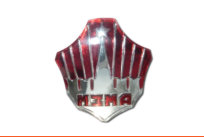
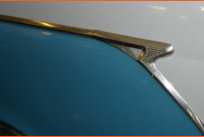
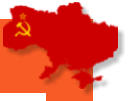
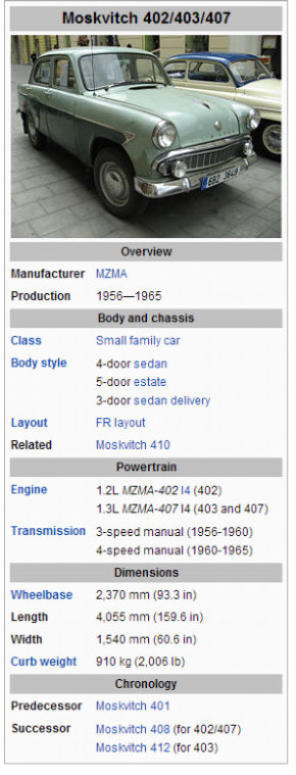
Photos mainly by Matti Kreivilä. Historical facts and technical details of the vehicles provided by Wikipedia. Movies YouTube.






